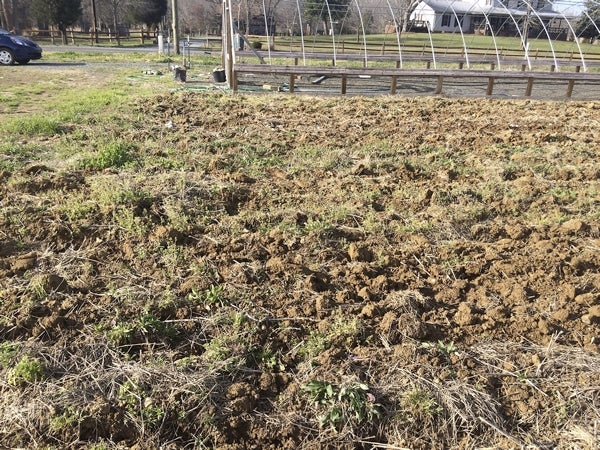Is your soil sick? Some remedies
Published 12:00 am Friday, March 24, 2017

- Submitted photo Tilled soil shows traces of a cover crop that will enrich the soil for planting.
By Amy-Lynn Albertson
Rowan Cooperative Extension
A healthy soil typically has more than 40 percent pore space, ranging from large pores, which allow drainage, to small pores, which help store water.
Every 1 percent increase in organic matter results in as much as 25,000 gallons of available soil water per acre.
One teaspoon of healthy soil contains 100 million to 1 billion individual bacteria. Healthy, fully functioning soil is balanced to provide an environment that sustains and nourishes plants, soil microbes and beneficial insects.
If you have poor soil, or poorly drained soil, all is not lost. There are many things a gardener can do to improve soil. Increasing the amount and size of pore spaces is an important first step.
Soils made up of small particles, such as heavy clay soils, naturally tend to have more small pores, even without compaction, making them difficult to work, difficult to wet and hard to aerate. Several methods can increase pore space in your clay soil.
While it is true that adding sand will increase the size range of the soil particles and pore spaces, it would take four to five times the volume in the sand to have a measurable effect. By adding a smaller amount of sand, it has an adverse effect, producing concrete-like material. Let me repeat, do not add sand to your clay soils.
A lot of people like to go out and get topsoil to add to their soil. Sometimes this works, especially for small areas, but can be expensive for larger areas. Also, there are no legal standards for topsoil. What is sold as “topsoil” may be no better than what you already have and may introduce new problems like weeds and soilborne diseases.
A more cost-effective solution for larger areas is to add organic materials, such as composted leaves, grass or wood bark. These materials will, over time, improve the structure and porosity of the soil and may enhance both drainage and nutrient retention.
It is important to use materials that have been composted because fresh organic materials will settle as they decompose. In the short term, adding organic materials may also increase the need for nitrogen, which is consumed by microbial activity during decomposition. However, in the long term, organic material added over several growing seasons will lead to the richer soil.
Another option for farmers and vegetable growers is the use of cover crops. A cover crop is a crop planted primarily to manage soil erosion, soil fertility, soil quality, water, weeds, pests, diseases, biodiversity and wildlife. An example of a cover crop that is commonly grown is crimson clover.
Usually, the cover crop is tilled back into the soil to improve the amount of organic matter and increase drainage. You can also use herbicides to burn down the cover crop and plant into the cover crop debris without tillage. Farmers who practice no-till farming (tilling the soil as little as possible) grow as many different species of plants as possible through crop rotation and a diverse mixture of cover crops.
Farmers who manage their land in ways that improve and sustain soil health benefit in many respects. Healthy soils help all producers, managers of large row crop operations to people with small, organic vegetable gardens.
Rowan Soil and Water Conservation District is sponsoring a Soil Health Field Day on Friday, March 31, at Morgan Ridge Vineyards from 9 a.m.-2:30 pm. Go to go.ncsu.edu/rowansoilhealth or call 704-216-8970 to register by March 28.
The workshop will begin at Morgan Ridge Vineyards and finish at Acorn Grove Farm. Acorn Grove Farm is the only vegetable farm in North Carolina to receive a Soil Health Grant through the N.C. Carolina Foundation for Soil and Water Fund.
Topics covered will include cover crops and no-till farming on a large and small scale. For more information about soil and soil health contact the Rowan County Extension Center at 704-216-8970 or on the web at http://rowan.ces.ncsu.edu.



